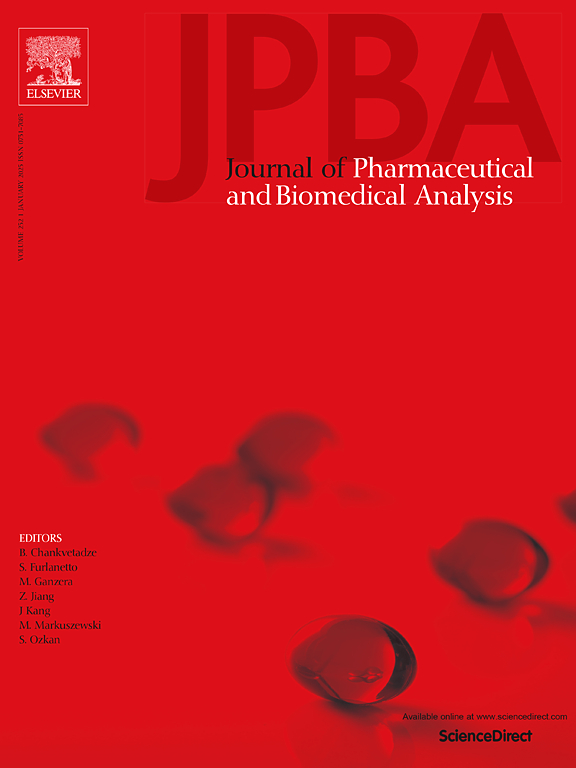Development of a fluorescence-based assay for screening of urate transporter 1 inhibitors (II): Optimization of fluorescent substrates and structure-activity relationships analysis
IF 3.1
3区 医学
Q2 CHEMISTRY, ANALYTICAL
Journal of pharmaceutical and biomedical analysis
Pub Date : 2025-04-11
DOI:10.1016/j.jpba.2025.116900
引用次数: 0
Abstract
Urate transporter 1 (URAT1) inhibitors represent a promising therapeutic approach for hyperuricemia and gout. A non-radioactive cell-based platform for screening URAT1 inhibitors using 6-carboxyfluorescein (6-CFL) was previously established by our team. In this study, aiming to optimize our testing platform, 10 potential fluorescent substrates were screened from the commercially available fluoresceins using molecular docking and pKa prediction. Among them, dibromofluorescein (DBF) and diiodofluorescein (DIF) were identified as specific transport substrates for UTAR1 with significant fluorescence changes in cellular uptake. DBF and DIF exhibited Km values similar to that of 6-CFL. Using DBF or DIF as substrates, the IC50 values of the URAT1 inhibitors benzbromarone and lesinurad remained within the same order of magnitude as those obtained by 6-CFL. Notably, DBF enables visual detection, further extending the utility of this non-radioactive platform for in vitro screening of URAT1 inhibitors. Molecular dynamics (MD) simulations and free energy calculations were employed to compare the interactions and binding affinities of 6-CFL, DBF, and DIF with URAT1, respectively. Finally, structure-activity relationships (SARs) analysis was conducted to preliminarily identify substituents modulating the binding affinity of commercially available fluoresceins.
开发一种筛选尿酸转运蛋白1抑制剂的荧光检测方法(II):荧光底物的优化和构效关系分析
尿酸转运蛋白1 (URAT1)抑制剂是治疗高尿酸血症和痛风的一种很有前途的方法。我们的团队先前建立了一个基于非放射性细胞的平台,用于使用6-羧基荧光素(6-CFL)筛选URAT1抑制剂。在本研究中,为了优化我们的测试平台,利用分子对接和pKa预测从市售荧光素中筛选出10个潜在的荧光底物。其中,二溴荧光素(DBF)和二碘荧光素(DIF)被鉴定为UTAR1的特异性转运底物,在细胞摄取过程中荧光变化显著。DBF和DIF的Km值与6-CFL相似。使用DBF或DIF作为底物,URAT1抑制剂苯溴马隆和lesinurad的IC50值与6-CFL获得的IC50值保持在同一数量级。值得注意的是,DBF可以实现视觉检测,进一步扩展了这种非放射性平台在体外筛选URAT1抑制剂的实用性。采用分子动力学(MD)模拟和自由能计算分别比较了6-CFL、DBF和DIF与URAT1的相互作用和结合亲和力。最后,进行了结构-活性关系(SARs)分析,初步确定了调节市售荧光素结合亲和力的取代基。
本文章由计算机程序翻译,如有差异,请以英文原文为准。
求助全文
约1分钟内获得全文
求助全文
来源期刊
CiteScore
6.70
自引率
5.90%
发文量
588
审稿时长
37 days
期刊介绍:
This journal is an international medium directed towards the needs of academic, clinical, government and industrial analysis by publishing original research reports and critical reviews on pharmaceutical and biomedical analysis. It covers the interdisciplinary aspects of analysis in the pharmaceutical, biomedical and clinical sciences, including developments in analytical methodology, instrumentation, computation and interpretation. Submissions on novel applications focusing on drug purity and stability studies, pharmacokinetics, therapeutic monitoring, metabolic profiling; drug-related aspects of analytical biochemistry and forensic toxicology; quality assurance in the pharmaceutical industry are also welcome.
Studies from areas of well established and poorly selective methods, such as UV-VIS spectrophotometry (including derivative and multi-wavelength measurements), basic electroanalytical (potentiometric, polarographic and voltammetric) methods, fluorimetry, flow-injection analysis, etc. are accepted for publication in exceptional cases only, if a unique and substantial advantage over presently known systems is demonstrated. The same applies to the assay of simple drug formulations by any kind of methods and the determination of drugs in biological samples based merely on spiked samples. Drug purity/stability studies should contain information on the structure elucidation of the impurities/degradants.

 求助内容:
求助内容: 应助结果提醒方式:
应助结果提醒方式:


